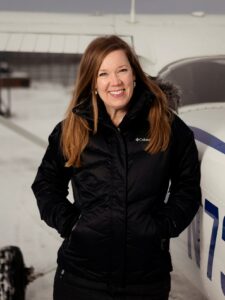
Meet Jamie Patterson-Simes, the owner of SkyTrek Alaska Flight Training, LLC. Jamie has earned her place among Alaska’s finest flight instructors by attaining Master Flight Instructor status and receiving the AOPA 2017 Flight Training Excellence Award. She is one of four NAFI Master Flight Instructors in the state of Alaska and uses only Gleim Aviation training materials with her students at her flight school.
Q: When did you know becoming a pilot, and later a CFI, was your passion?
A: When I was seven years old I took my first plane ride to visit my grandparents. I got off the plane and said, “Someday I’m going to be a pilot.” Ten years later I soloed. I have been flying ever since. I attended Embry Riddle Aeronautical University Prescott and in 1993, I became a flight instructor. It was really the only way to gain flight hours back then, because the airlines were not hiring. Like many flight instructors starting out, I was very inexperienced with very few flight hours. I was not a very good or effective flight instructor when I started out. I stepped away for a few years and flew as a Bush Pilot in Western Alaska (across from Russia) and was a pilot around Denali (the tallest mountain in North America) for a few seasons. The experience gave me a new perspective on teaching and a renewed sense of purpose.
Q: How did you end up in Anchorage, Alaska and decide that would be your home base for a flight school?
A: I was one of 13 CFIs working at Walmart in Prescott, Arizona. In the winter, pilots would come down from Alaska to train and they told me incredible stories of flying up North. I was mesmerized and formulated a plan to move. I saved up enough money for a one-way plane ticket and arrived in Anchorage on April Fool’s Day 1995 with one duffle bag and stayed at the youth hostel downtown. I landed a job flight instructing within a week. I love flying in Alaska. It is an amazing place to fly.
Q: Describe your flight school facility and fleet of planes.
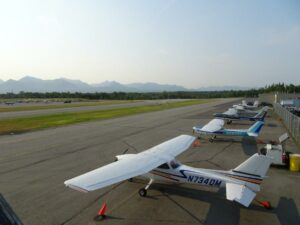
A: SkyTrek operates out of a renovated building with a hangar downstairs and classrooms upstairs with a fireplace and wood floors. In the winter, everyone takes off their shoes upstairs to keep the floors clear of mud and snow. I have two airplanes: a Cessna 150M and a Cessna 172N. Most students fly the Cessna 150 because it’s more economical. I can load the Cessna 150 with a 180-pound student, full fuel, survival gear and myself and still not max out the gross weight. We have incredible performance at sea level. In the winter months it is not uncommon to get density altitudes of MINUS 4,000’!
Q: How does SkyTrek Alaska Flight Training teach the specialized skills required to fly in Alaska’s unique environment, weather, and terrain?
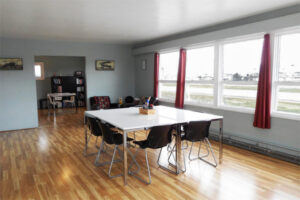
A: There are a lot of resources available for pilots in Alaska to help them make critical go/no-go decisions. I am always pointing out the different weather patterns that come off of the Aleutian Chain and out of Siberia so that they will become familiar with storms and low pressure systems that can move quickly. We fly into the mountains to ensure that they know how to turn around and glacier flying is another type of skill I teach. I learned a lot flying around Denali. Students need to know how to access the FAA Webcams, read TAFs, METARs, NOTAMs, AIRMETs and SIGMETs. We get volcanic ash SIGMETs in Alaska and those are important to know how the ash cloud is moving. We also get lots of little earthquakes. Last week, right before my student soloed for the first time, the Tower called out that there was an earthquake but we were flying in the pattern and both of us just shrugged our shoulders. It’s part of life up here.
Q: SkyTrek Alaska just received the AOPA’s 2017 Flight Training Excellence Award for Best Flight School-National. What does that distinction represent to you, and what about SkyTrek Alaska makes it stand out from the other flight schools in the country?
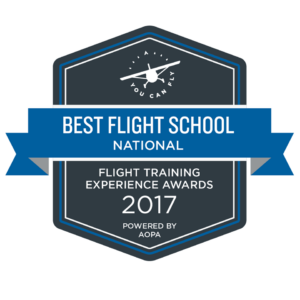 A: I was stunned and deeply honored to be chosen by my students for this award. I have always admired the advocacy that AOPA does on behalf of pilots, and their training resources are incredible! One of the things that I believe I do differently is the amount of time I spend on ground lessons. I feel that the ground time is just as valuable as the flight lessons. I find it very easy to teach the mechanics of flying, because most students pick those up rather quickly. But many students either have very poor study habits or they just don’t want to study. I don’t let them go on their cross country flights unless they’ve passed the FAA Written Exam. Gleim definitely helps with that!
A: I was stunned and deeply honored to be chosen by my students for this award. I have always admired the advocacy that AOPA does on behalf of pilots, and their training resources are incredible! One of the things that I believe I do differently is the amount of time I spend on ground lessons. I feel that the ground time is just as valuable as the flight lessons. I find it very easy to teach the mechanics of flying, because most students pick those up rather quickly. But many students either have very poor study habits or they just don’t want to study. I don’t let them go on their cross country flights unless they’ve passed the FAA Written Exam. Gleim definitely helps with that!
Q: How does the flight school operate around and take advantage of the extended hours of daylight and darkness during the solstices?
A: In the summer months we can fly until 2:00 a.m. and still have to wear sunglasses. The winter is a little more challenging. During winter solstice the sun comes up this year at 10:14 a.m. and sets at 3:41p.m. (local). That gives us plenty of time to complete flights. The regulations give us a little more leeway in the summer, because Alaska has a special exemption that allows aviators to get their license with a night restriction (14 CFR §61.110) and complete their night requirements within 12 months of their rating, when it’s dark out. In the winter we can actually get our night flying done in the morning, before work!
Q: What changes in aviation education have you noticed since you became a CFI in 1993?
A: Many of the CFIs don’t know how to teach using basic attitude flying; they are dependent upon their PEDs (Personal Electronic Devices). These are great for teaching Instrument students, but I strongly believe that pilots need to learn the basic steam gauges BEFORE they learn how to use glass. It’s not uncommon for me to get a student from another flight school who has logged 100+ hours in their logbook, but never used a VOR and doesn’t even know what it’s used for. That’s a failure on the CFI’s part.
Q: Describe the role you play in supporting the aviation and airport communities in Anchorage and beyond.
A: I was elected Chair of the Municipal Airports Aviation Advisory Commission. I am also a Corporate Member of the Alaska Airmen Association and a Board Member of the Lake Hood Pilots Association. I go to as many aviation meetings as possible, and I strongly advocate for more women and minorities to become pilots. Flying is a great career for anyone!
Q: What is your favorite plane to fly and why?
A: Most people would answer this question with a very fast or exotic airplane. I am going to say my little, trusty Cessna 150. We’ve been together in Alaska since I first started flying up here. It was one of the first planes I instructed in in 1995. In 2008, the owner contacted me, and wanted me to fly it so the engine would run regularly (she didn’t want it to sit on the ramp). I flew it until 2011 until she decided to sell it to me. I started the flight school with this airplane and over the years it has put hundreds of students through their training.
Q: Why are Gleim Aviation training materials your exclusive choice for your school and students?
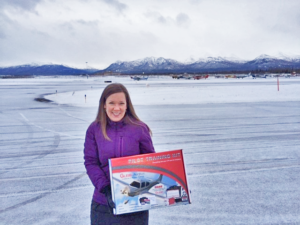
A: They were the first materials that I used at Embry Riddle when I was learning to fly, and I’ve been using them ever since. I like to give this example: I had two students learning at the same time. The first student took an entire semester of Private Pilot Ground School at the local university. He passed his FAA Written with a 77%. The second student studied for three weeks with his Gleim Private Pilot Kit, and passed his FAA Written with a 93%. My students have been getting excellent results with the Gleim study materials!
Gleim Aviation would like to congratulate SkyTrek Alaska Flight Training and Jamie Patterson-Simes for receiving the 2017 AOPA Flight Training Excellence Award for Best Flight School-National and thank them for their support and dedication over the years!
For more information about SkyTrek Alaska Flight Training, visit skytrekalaska.com.
About Gleim Aviation
Since 1980, Gleim Aviation’s team of pilots, instructors, writers, designers, and programmers has helped aviators pass millions of FAA knowledge and practical tests using the unique Gleim Knowledge Transfer System. Gleim is an environmentally-friendly company headquartered in Gainesville, FL.

